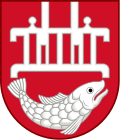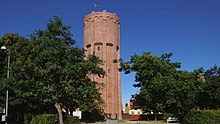Skagen
| Skagen | ||||
|
||||
| Basic data | ||||
|---|---|---|---|---|
| State : |
|
|||
| Region : | North Jylland | |||
| Region : | North Jylland | |||
|
Municipality (since 2007) : |
Frederikshavn | |||
| Coordinates : | 57 ° 43 ' N , 10 ° 35' E | |||
|
Population : (2020) |
7,845 | |||
| Area : | 143 km² | |||
| Population density : | 55 inhabitants per km² | |||
| Postal code : | 9990 | |||
| Sister cities : |
|
|||
| Website: | www.skagen.dk | |||
 Church in Skagen (2018) |
||||
( ˈskɛˀjn̩ ) is the northernmost city inDenmarkand part of themunicipality of Frederikshavn,Region Nordjylland. The important port city has 7,845 inhabitants (as of January 1, 2020), is a well-frequented seaside resort, is located on the northern tip ofJutlandand has long sandy beaches for tourists. The port,Skagen Havn, is the largest fishing port in the country.
However, the place owes its international standing to the Skagen painters , a group of predominantly Scandinavian artists who made the fishing village their summer retreat at the end of the 19th century. The area around Skagen is still picturesque today. The cityscape is dominated by small, ocher-plastered houses with red tile roofs. The fishermen used their white roof joints as landmarks.
geography
Skagen consists of several districts that have grown together to form a closed settlement area over the decades: Gammel Skagen (officially: Højen), Kappelborg, Nordby, Vesterby and Østerby.
North of Skagen is the flat headland of Grenen , where the Kattegat and Skagerrak converge clearly.
In the past, the area south of Skagen consisted almost entirely of shifting dunes. They were planted to build a permanent road connection to Skagen. South of Skagen is still Denmark's largest shifting dune , Råbjerg Mile , with an area of over 1 km².
history
The landscape protruding into the sea gave the place its name, which is derived from the Old Norse word skaga (English: “protrude”) or from the Old Danish skaghi (English “headland”).
Traces of the first settlement north of the hill Fyrbakken can be found from 1250 . Skagen was first mentioned in 1299; In 1413 the fishing village was granted market rights, and in 1507 city rights. In 1672 the city already had a population of just over 1000 - despite wars, a decline in fishing, storm surges and silting up through shifting dunes.
Over the centuries, due to numerous strandings, several lighthouses have been built to orientate shipping: 1560 the first rocking light, 1746 Det Hvide Fyr , 1848 Skagen Fyr or Det Grå Fyr and 1956 Skagen Vest . The era of the Skagen painters began in the 1870s, and Skagen's special lighting mood exerted a special charm.
In 1890 the Frederikshavn – Skagen line was opened as a narrow-gauge railway to Frederikshavn. With the construction of this railway line, a train station was put into operation in Skagen in 1890, for which the first station building had been built according to plans by the architect Thomas Arboe. As a result, Skagen already had Denmark's northernmost train station in the 19th century. Since the railway connection had been well received by the population, the local trade and the port companies, planning for a larger station building began at the beginning of the 20th century, which was built in a neoclassical style according to plans by the architect Ulrik Plesner and put into operation as early as 1919. A reconstruction of the railway systems was tackled a short time later, so that in 1924 the railway line from Frederikshavn to Skagen could be converted to standard gauge over 40 kilometers. At the same time, the tracks of the Skagen port railway were expanded. From 1924, the railway operator was Skagensbanen A / S (SB), which merged with A / S Hjørring Privatbaner on September 11, 2001. The railway company Nordjyske Jernbaner emerged from the merger.
In 1906 there was a shipwreck near Skagen. In the accident, the German fishing steamer Comet collided with the Swedish Bark Cometen , which sank.
In 1907 the new port, Skagen Havn, was opened . It is currently the largest fishing port in the country. The most recent expansion was completed in spring 2015, and cruise ships have also been able to call at the port since then .
From 1970 to December 2006 Skagen formed its own municipality Skagen with the villages of Bunken , Hulsig , Kandestederne , Skiveren , Tuen and Ålbæk . Since January 1st 2007, Skagen belongs to the municipality of Frederikshavn as a dependent municipality.
Attractions
In the Skagens Museum Art Museum , works by the former artist colony of the Skagen painters are on display. The collection includes around 1,900 naturalistic, realistic and impressionistic works. The Grenen Art Museum has existed since 1977.
The nature center Skagen Odde nature center has been offering information on the topics of sand, water, wind and light since May 2000 to understand the natural phenomena that are particularly impressive at the confluence of the North Sea and Baltic Sea.
Skagen also has a natural history museum and an amber museum.
The Church of Skagen was built in 1841/1910 and is situated in the city center.
The brick water tower from 1934 now serves as a lookout tower and offers a wide all-round view due to its height of 34 meters.
The Vippefyret is within sight of the two lighthouse structures in the north-east of Skagen , which by means of a wooden construction used a fire sign at night with an upwardly pivoting fire basket to ensure safety for seafaring near the coast. The Vippefyret, now just a copy, was a forerunner of the lighthouses from 1627 to 1747.
To the silted up church (Tilsandede Kirke) St. Laurentius follow the Primærrute 40 road from Skagen southwest about 3 kilometers to a left-hand parking lot and from there continue on a hiking trail about 1.5 kilometers east of the highway into a dune landscape . The church dates from the 13th century, but had to be abandoned because of the incessant drifting sand.
Not far from the headland of Grenen, below a lookout point in the dunes, there is a crypt with the grave of the Danish poet Holger Drachmann . The copper gate to the crypt was designed by Drachmann's friend from the Skagen artists' colony, Peder Severin Krøyer. Drachmann, who also painted North Jutland motifs as a trained painter, came to Skagen at the age of 56 and died a few years later in 1908 in Hornbæk, Zealand. The transfer takes place by ship to Frederikshavn and further by train to Skagen with subsequent burial with great sympathy of the population.
beacon
Skagen has several night nautical marks. Most noticeable is the lighthouse , which is the second highest in Denmark at 46 m and is electrically operated. Skagen residents also call it the Gray Tower .
A little further south there is a former lighthouse ( white tower ) closer to the place , which stands out from the brick water tower by its white color. Near the replica of a 1560 originally built stands Feuerblüse : A filled with burning wood iron basket was promoted via a rocker design in the air and the fire by visible from afar.
These three beacons are located on the Baltic Sea side of Skagen. In order to warn seafarers in the North Sea of Grenen , a beacon was also set up in Højen ( Gammel Skagen ), which consists of a pyramid-shaped wooden frame. In 1956, the Skagen West lighthouse was also built on the west coast as a narrow concrete tower.
Headland Grenen
Thorvald Bindesbøll designed the packing houses in the port of Skagen in 1907 based on the model of the German Bridge in Bergen .
Town twinning
-
 Chenderiang , Malaysia
Chenderiang , Malaysia
-
 Farsund , Norway
Farsund , Norway
-
 Kristinehamn , Sweden
Kristinehamn , Sweden
-
 Qingdao , China
Qingdao , China
-
 Seinäjoki , Finland
Seinäjoki , Finland
-
 Sisimiut (Holsteinsborg) , Greenland
Sisimiut (Holsteinsborg) , Greenland
Personalities
Sons and daughters
- Anna Ancher (1859–1935), painter
- Kamilla Rytter Juhl (* 1983), badminton player
People with a relationship to the city
- Georg Brandes (1842–1927), writer
- Holger Drachmann (1846–1908), writer
- Michael Ancher (1849–1927), painter
- Peder Severin Krøyer (1851–1909), painter
- Christian Krohg (1852–1925), painter
- Henrik Pontoppidan (1857–1943), writer
- Marie Krøyer (1867–1940), painter
- Hugo Alfvén (1872–1960), composer
Individual evidence
- ↑ a b Statistics Banks -> Befolkning og valg -> BY1: Folketal January 1st efter byområde, alder og køn (Danish)
- ^ Svend Sørensen: Politics bog om Nordjylland . Politics Forlag A / S, Copenhagen 2004, ISBN 87-567-6890-7 , Skagen, p. 66 ff . (Danish).
- ↑ Meaning of different place names (Danish) Nordic Research Institute of the University of Copenhagen, June 7, 2014. In modern Icelandic skagi is the word for peninsula .
- ^ A b Søren Olsen: Danmarks Købstæder . 1st edition. Politics Forlag A / S, Copenhagen 2000, ISBN 87-567-6203-8 , Skagen, p. 39 ff . (Danish).
- ↑ Krydstogtskibe skaber boom i Skagen Berlingske Business, July 12, 2015.














